There’s not much that Orla Barry doesn’t know about wool and about felting, the process of – let’s see if we have this right – pressing the fleece together into jumper-ready fibres.
“In the last few pieces I’ve made I used Hebridean wool,” the Waterford artist and farmer says. “I tried using Lleyn wool in 2011 and I nearly killed myself trying to felt it. It was a very physical job. I worked with a felter in Holland this time. And she said maybe we should mix the Lleyn with Bergschaf, a breed from the border between Austria and Italy. That simple idea I had of overseeing the process from beginning to end suddenly became about production. It’s complicated.”
Barry is a multidisciplinary artist who lived and practised in Brussels for 16 years. She has written, performed and exhibited video and sound installations at the Irish Museum of Modern Art, Tate Modern, in London, Mu.Zee, in Belgium, and the former Museu Coleção Berardo, in Lisbon, as well as winning a Belgian Art Prize. She never anticipated sheep in her life.
“I grew up on a tillage firm in Wexford,” she says. “All I wanted to do was get away from the farm. So I went first to Dublin for a year, then to Belfast, then to Holland and Belgium. My work was inspired by the area I grew up in. I used to come back all the time. I made some films in the early 2000s here in Wexford. But the place was more about the landscape. I never thought about farming.
Alzheimer’s: ‘I’ve lost my friend and my companion,’ says Úna Crawford O’Brien of fellow Fair City actor Bryan Murray
Ryan Adams at Vicar Street: A gig that nobody will forget anytime soon, but perhaps not for all the right reasons
Meghan Markle’s new podcast: An ego-fluffing conversation underlining the culture gap between Ireland and the US
“Then I came back to live here in 2009. My then partner and our adopted children came to join me, and we needed an income. I had built a house on my father’s farm. My uncle was a big sheep farmer. There was no way I was doing something without being professional. So I went from zero to 30 pedigree sheep straight off. The local farmers, my friends, my uncle and my godfather became my own little hedge school.”
Sheep have long had a special place in visual art. Since the earliest Christian artworks the lamb has served as a visual representation of Christ. The 19th-century French painter Jean-François Millet bathed his flock in a warm, nostalgic glow. Picasso gave a ruminant sheep a cubist makeover in his 1965 work Spring. Damien Hirst’s Away from the Flock suspended the animal in formaldehyde. Sheep have recently taken starring roles in the international box-office hits Rams and Woman at War.
In Ireland, too, the woolly creatures are having a moment. John Connell’s Twelve Sheep: Life Lessons from the Lambing Season was a deserving springtime bestseller.

Barry, meanwhile, has drawn on her experiences as a sheep farmer to create publications and performances that marry autobiography, fiction, environmentalism and, well, sheep.
Her efforts have coalesced into a shifting job description. “There have been different permutations over the years. Sometimes farmer. Sometimes shepherdess. Now I use the word shepherd even though it’s kind of antiquated. Sure, I’m a farmer, but I only deal with sheep. I don’t have an extended farm like my dad had, with cattle and tillage. And I didn’t really want to be associated with the word shepherdess. It was too much like something out of a nursery rhyme. So shepherd became my job.”
Cara Holmes is a film editor and director best known for her work on the admired documentaries The Father of the Cyborgs and Piano Dreams. She was introduced to Barry through Liz Burns, a mutual friend working for the arts department at Waterford County Council. The caveat? She’s not like other farmers.
“I was intrigued straight away,” says Holmes. “I was interested in doing a documentary about women in farming and the history of women and farming in Ireland. “I was curious about feminism and farming and the politics around that – what it means to be a woman in farming. The idea was quite a generic treatment. So I kind of held off and I didn’t do anything with it. Until I met Orla.”
The resulting collaboration is Notes from Sheepland, a portrait of the artist as a farmer and Holmes’s feature debut as a director. This innovative documentary adapts Barry’s iPhone chronicle Sheepland Diary and her 2019 book Shaved Rapunzel, Scheherazade & the Shearling Ram from Arcady into a pleasing marriage of farming journal, performance art and portrait of rural life.
“It’s proper country living,” says Holmes. “Orla lives very close to the sea and a lake. There’s swimming and freedom. She wanted to keep the fields alive. That was the key thing. And that was the reason to make the film as far as I was concerned. We were in and out of the shed from dawn till dusk. But I certainly gained an insight into what Orla loved so much.”
Notes from Sheepland is a rich tapestry. A local male choir appear on Barry’s farm singing Rise Up, Shepherd, and Follow. Barry ponders her work and its relationship to the land and her dyslexia. Chickens and sheepdogs run amok. And then there’s the all-star pedigree flock.
“When I started with pedigree sheep I didn’t even realise what was involved,” says Barry. “I thought, oh, we could show these. I went along, doing it, not realising that what I was doing is actually an art form. Breeding animals is like making an artwork. You’re putting certain animals together. With the Lleyn you are breeding from females instead of males. Most breeds, you are breeding from rams. They are a very ecological breed: they produce a lot of milk; they don’t need a lot of inputs. They are easy lambers. They are quite a natural breed. Whereas, if you are working with a breed like the Beltex, they are muscular, bred for meat, and difficult to lamb. Everywhere I go there’s a sheep. It’s the most incredible animal, and it has such a history in this country.”
The film opens with a close-up of Barry’s eye; ovine, she says, signifying her destiny. Elsey was the first among Barry’s pedigree flock; she was soon joined by Gillian, Big Daddy, Little Daddy, the Ugly Mutt, the Log, Michelle, Patsy, Iris, Ivy and other costars. Barry’s empathy as an artist and animal companionship does not, apparently, conflict with the ultimately grisly business of the abattoir.
“People often ask if I’m sad to see them go to be slaughtered,” she says. “I’m quite hard-nosed about it. Because that means less work for me. But what is hard is seeing the mothers – the ewes – go, because they’ve lived with me for 10 years.
“And what’s also really hard to face is not so much the killing of an animal as the massive industry around it. I’ve been to the factory, what all the farmers call the factory. They don’t call it the slaughterhouse. All the packing is done there, and the meat is sent to a supermarket chain in Belgium.
“This is a big industry. It upsets me how poorly farmers do out of that industry. That upsets me more than the actual killing of an animal.”
During Notes from Sheepland, Barry recalls her first acquisitions and says, “I think if I’d known what was coming I would have sold them all again immediately.” Sheep may be incredible, but they are not lucrative. The film’s tartest irony is that a profession Barry embraced as a route to financial security, to offset her artwork, has proved equally precarious.
“We’ve had screenings all over the country,” says Holmes. “We’ve had one in Leitrim recently and we’ve had one in Estonia, And the Estonian farmers put their hands straight up for questions. We were trying to make these connections. It’s the same situation everywhere: they’re very much responding to the world of the small farmer, and the challenges of that.”
Following an injury and the acquisition of a half-ton of unsold wool – it would cost more to ship it to a buyer than to produce it – Barry’s flock has dwindled. She remains a shepherd and a sheep-inspired artist. Her next collection, Shaved Rapunzel et le Petit Berger Punk (to use its French title) is on it way.
“The lived experience of raising sheep is so important for me,” says Barry. “I’ve reduced my flock. But I’m too addicted to sheep to get rid of them.”
Notes from Sheepland opens on Friday, July 26th




















